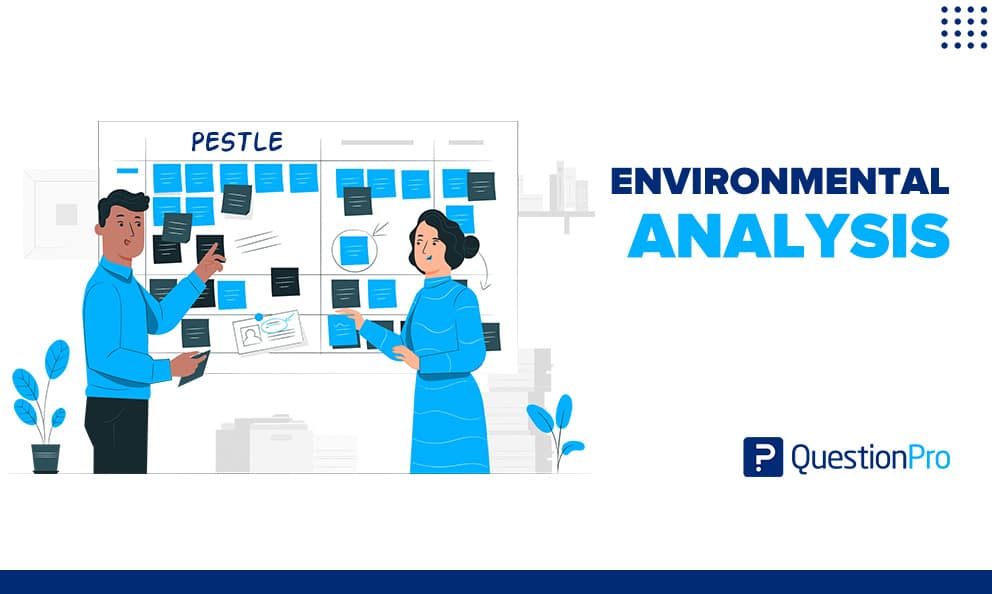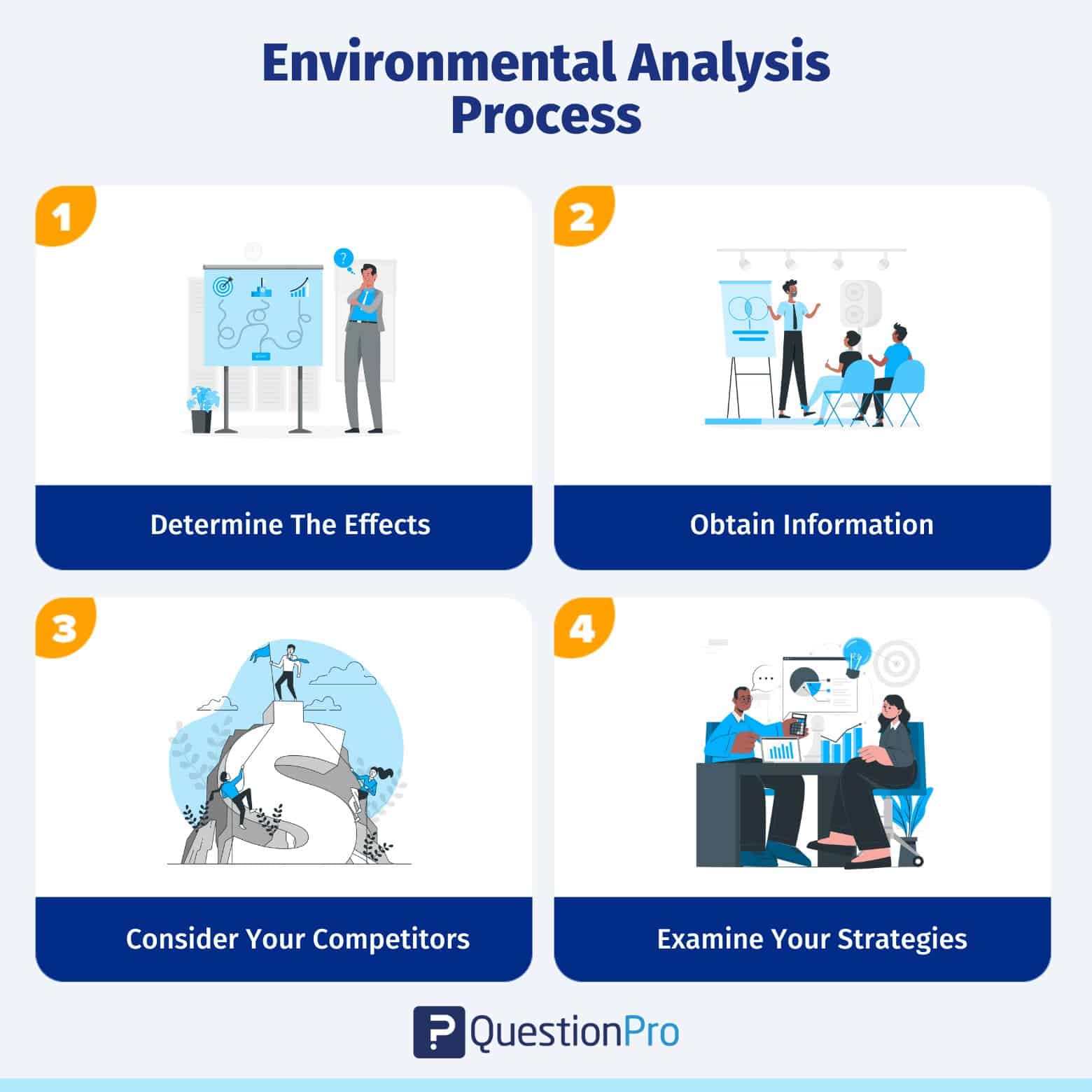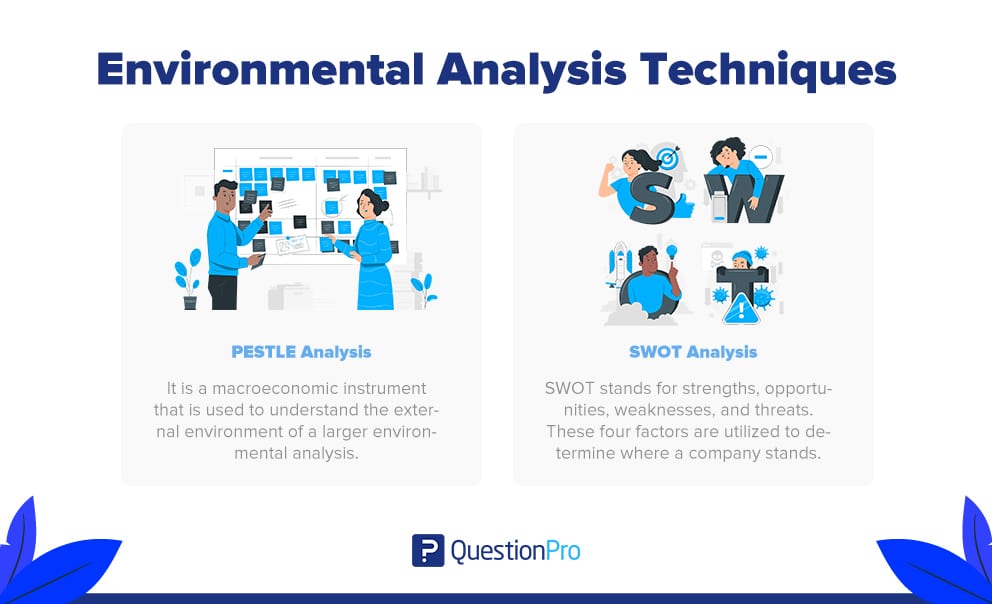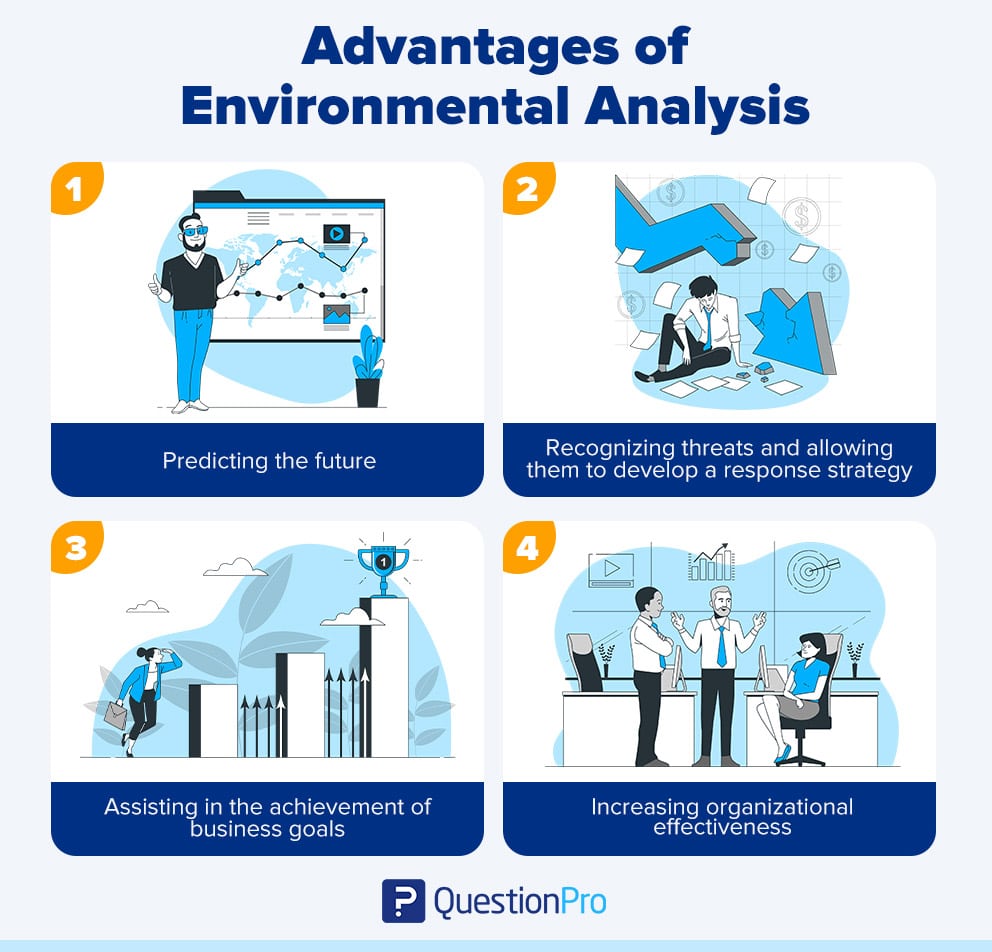
Organizations can use an environmental analysis to uncover both internal and external factors. This could have a beneficial or negative impact on their company. Businesses can identify possible opportunities and challenges by analyzing factors such as the economy and technology.
Several factors come to mind when analyzing what makes a business successful. It’s all about the resources. However, the environment in which the business operates or exists also has a significant impact.
In this article, we look at what environmental analysis is, why it’s useful, how to do one, the analytical research process, and the tool’s analysis.
What is environmental analysis?
An environmental analysis is a strategic technique used to identify all internal and external factors that could affect a company’s success. Internal components reveal the strengths and shortcomings of a company, while external components represent the opportunities and risks. This exists outside of the company.
Trends and high-level factors are considered in it; another name for this is environmental scanning.
Interest rates, for example, and how they may affect a company’s operations. These analyses can help businesses achieve attractiveness in their market.
Importance of environmental analysis
Organizations need to do environmental analysis because it helps them:
- Find opportunities: By looking at the outside world, organizations can find new trends and chances to enter new markets or make new products or services.
- Identify threats: It helps businesses find threats to their business, such as new competitors, changes in regulations, or a slowing economy.
- Create effective strategies: Organizations can create effective strategies that are in line with their goals and objectives when they understand how the outside world affects their business.
- Anticipate change: Environmental scanning helps organizations plan ahead for changes in the outside world and create strategies to deal with them.
- Make informed decisions: It helps organizations learn more about the outside factors that affect their business so that they can make better decisions.
Organizations that want to stay competitive and successful in a business world that is changing quickly need to do environmental analysis. It helps them take advantage of opportunities, lower risks, and come up with good plans that lead to growth and success.
Environmental analysis process
Environmental analysis is the process of assessing and evaluating the internal and external factors that can have an effect on an organization’s performance and strategy. This analysis aims to find opportunities, threats, strengths, and weaknesses so that the organization can make a good workforce strategy that fits its goals and objectives.
The environmental analysis process usually involves the following steps:

1. Determine the effects on the environment
To begin a business environmental analysis procedure, select environmental factors evaluating. Your industry determines this.
For example, if you work in a medical facility, you might want to think about legal implications. Regulations managing healthcare experience and safety, for example. Choose factors that have the potential to influence how you make deals.
2. Obtain information
Collect information about your chosen environmental factors once you decide which ones to evaluate. You can observe your factors and conduct research here. There are two types of information to gather: verbal and written data. Hearing is how people obtain verbal information.
As an example, consider listening to a radio broadcast. They obtain written information from sources such as newspapers and magazines.
Using the preceding example, this would involve conducting research online and in medical magazines.
It will assist you in determining whether or not there have been any changes to health and safety regulations because this may have an impact on your healthcare facility.
3. Consider your competitors
You may want to gather information about your competitors. To see if they pose any threats. You can accomplish this by employing a technique known as spying. This involves unusually gathering information.
Using the same example, you could spy on a nearby health facility to learn about recent activity.
4. Examine your strategies
Finally, evaluate your present and prospective strategies to determine how future environmental changes will impact your organization. This assists you in resolving potential issues. These factors could have been to blame.
For example, the health facility may wish to develop a new strategy. It will clearly show how they aim to deal with the decrease in clients caused by their competitor’s new branch.
Environmental analysis tools
Environmental analysis is frequently used to assist businesses. It is used before launching a new product or service.
For example, survey the landscape of competitors, customers, economic conditions, market conditions, and so on. PESTEL is a popular project management tool for performing this analysis.
It refers to the factors that are political, economic, social, and technological. The various components of a PESTEL analysis are listed alphabetically below.
Political
Political issues refer to the level of government intrusion into an organization’s operations. Primary concerns include taxes, tariffs, regulations, elections, and political stability.
For example, different political parties hold divergent viewpoints on raising the minimum wage. Small businesses may be affected by an election.
When one candidate proposes raising the minimum wage, it may impact their product/service prices and ability to retain current employees.
LEARN ABOUT: Workforce Planning Model
Economic
Businesses in the United States first consider the overall health of the American economic factors. Growth, employment, inflation, and interest rates are just a few examples. Organizations operating outside of the United States will concentrate on exchange rates.
A startup, for example, may assess the current state of the economy to determine whether or not it will be able to survive. The long-term revenue and expenses of a company are affected by economic conditions.
Social
Shifts in age, demographic changes, changing attitudes toward safety and health, customer preferences, and technical improvements. All are examples of social challenges. 86 percent of young people, for example, use social media.
As a result, of successful business strategies, millennials are more likely to run promotional ads, especially on social media platforms.
Technology
The technology involves research and development, robotics, automation, and any other type of technological advancement. New technologies are referred to as “technological disruption.” It has the ability to change the cast of leading competitors dramatically.
For example, the popularity of Facebook was a technological challenge for Myspace. It was once the most popular social media network in the early 2000s.
Environmental
Climate change, weather, air quality, and natural disasters are examples of environmental factors. Changes in the environment threaten some industries more than others.
Farmers, for example, could watch the Weather Channel or read the Farmer’s Almanac. Because pesticide treatment, irrigation schedule, planting dates, and fungicide application are all affected by the weather.
Legal
Legal factors involve employment, health, and safety policies. Customer safety and discrimination laws can also have an impact on a company’s capacity to operate.
Congress, for example, passed the Dodd-Frank Act in 2009. Following the Great Recession, banks were subjected to strict requirements to protect customers.
Environmental analysis techniques
A corporation can use environmental analysis techniques in a variety of ways. But some are more frequent. The PESTLE study is the most widely used tool for conducting a complete business or industry environment analysis.

PESTLE Analysis
This is essentially a bird’s eye view of corporate behavior. Because we take a broad look at some macro issues that significantly impact the health of a particular business or industry, this study is used by managers and strategists to determine where their market is right now. It also assists in evaluating the company’s future position.
The PESTLE study considers several factors that have an impact on the business environment. It is a macroeconomic instrument that is used to understand the external environment through more extensive environmental analysis.
Each letter in the acronym represents a different component. These factors can directly or indirectly impact any sector or organization.
SWOT Analysis
SWOT stands for strengths, opportunities, weaknesses, and threats, in case you didn’t know. These four factors are utilized to determine where a company stands regarding strategy.
These four elements are divided into two groups. We must talk about them a bit to see how they can assist us in conducting an environmental study.
- Internal Factors
Internal factors in this type of analysis are strengths and weaknesses. Because they can be affected and even controlled by the organization, they are referred to as internal analysis if a corporation has a firm brand name.
This is a strength because it was made possible by the organization’s efficient use of resources. As a result, this is an internally generated element that highlights one of the causes of the company’s success.
- External Factors
External considerations in this type of environmental assessment include threats and opportunities. Unlike the elements listed above, the company cannot control them in any way. In fact, these circumstances frequently occur on their own.
Competition is a concern to all businesses since it is impossible to eliminate it. As a result, external factors function in this manner.
Now that you know how to do a SWOT analysis, you can include your findings in your environmental study. Strengths may be enhanced, weaknesses can be eliminated by taking advantage of opportunities when they arise, and threats can be minimized by remaining vigilant.
Benefits of environmental analysis
Environmental evaluations help organizations in detecting potential effects. That could pose a hazard or an opportunity. This assists them in anticipating changes in their environment.
The internal insights from the environmental analysis are used to evaluate things like how well employees are doing their jobs, how happy customers are, how much maintenance costs, etc., so that corrective action can be taken where needed.
Also, the external metrics help the organization positively respond to its environment and ensure its strategies align with its goals.
This helps to find threats early on, which helps the organization come up with plans for how to stay alive. On top of that, it looks for opportunities, like potential customers, new products, segments, and technologies, so that it can take up the most market share possible compared to its competitors.
Using environmental factors analysis has several advantages, including the following

- Predicting the future
- Recognizing threats and allowing them to develop a response strategy
- Assisting in the achievement of business goals
- Increasing organizational effectiveness
Conclusion
The analysis examines revenue, profitability, and company success in depth analysis. An environmental analysis can help you make the best decisions for your company. The nature of your business determines the type of environmental analysis you should perform.
It helps companies uncover opportunities, minimize risks, and create successful strategies that meet their goals.
SWOT, PESTEL, and Porter’s Five Forces analyses are used to evaluate an organization’s performance and strategy.
Environmental analysis helps organizations anticipate change, make informed decisions, and stay competitive in today’s fast-changing business environment. Environmental scanning has several benefits and is vital for today’s businesses.
QuestionPro can help with environmental analysis by giving you tools for gathering, analyzing, and displaying data. It can also help you target specific audiences and work together as a team.
QuestionPro makes it easier for businesses to learn about environmental factors that affect their business and make decisions based on that information.







